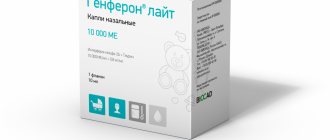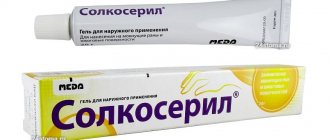Pharmacological properties
Pharmacodynamics
Oxymetazoline belongs to the group of alpha-agonists for topical use. Has a vasoconstrictor effect. When administered intranasally, it reduces swelling of the mucous membrane of the upper respiratory tract and nasal discharge. Restores nasal breathing.
Elimination of swelling of the nasal mucosa helps restore aeration of the paranasal sinuses and middle ear cavity, which reduces the likelihood of bacterial complications (sinusitis, sinusitis, otitis media). When used locally intranasally in therapeutic concentrations, it does not irritate or cause hyperemia of the nasal mucosa.
Oxymetazoline begins to act from 25 seconds. The duration of action of the drug is up to 12 hours.
Pharmacokinetics
When administered locally intranasally, oxymetazoline does not have a systemic effect. The half-life of oxymetazoline when administered intranasally is 35 hours. 2.1% of oxymetazoline is excreted by the kidneys and about 1.1% through the intestines.
Rhinostop
STUFFY NOSE?! RINOSTOP® SPRAY – ACTIVE IN A FEW MINUTES1, COSTS INEXPENSIVE!
for adults and children from 2 years old
Advantages of the drug
- has a local vasoconstrictor effect
- due to narrowing of the blood vessels of the nasal mucosa:
- helps eliminate swelling and hyperemia (redness) of the mucous membrane
- helps relieve nasal congestion
- helps restore patency of the nasal passages and facilitate nasal breathing
Advantage of the release form
- 2 release forms provide the possibility of using the drug in people of different age groups:
- nasal spray 0.05% – 15 ml: for children from 2 to 6 years old
- nasal spray 0.1% - 15 ml: for adults and children over 6 years old
Indications for use
- acute respiratory diseases with symptoms of rhinitis (runny nose)
- acute allergic rhinitis
- sinusitis,
- eustacheitis
- hay fever
- otitis media (to reduce swelling of the nasopharyngeal mucosa)
- preparing the patient for diagnostic manipulations in the nasal passages
Rinostop is the winner of the “No. 1 Brand in Russia” award in the category of means for treating the common cold in 2021.
Carefully
With increased intraocular pressure, chronic heart failure, arterial hypertension, angina pectoris; arrhythmias; chronic renal failure; in patients with prostatic hyperplasia with clinical symptoms (urinary retention); severe atherosclerosis; with hyperthyroidism; diabetes mellitus; pheochromocytoma; tachycardia; therapy with monoamine oxidase inhibitors (MAO) (including for up to 14 days after their discontinuation) and tricyclic antidepressants, as well as other drugs that increase blood pressure; porphyria; pregnancy, during breastfeeding.
special instructions
Long-term use and overdose of the drug should be avoided, especially in children. Avoid contact of the drug with the eyes. To avoid the spread of infection, it is necessary to use the drug individually.
Impact on the ability to drive vehicles and machinery . After long-term use of cold remedies containing oxymetazoline, and in doses higher than recommended, a general effect on the cardiovascular system cannot be excluded.
system and the central nervous system. In these cases, it is recommended to be careful when driving vehicles and engaging in other potentially hazardous activities that require increased concentration and speed of psychomotor reactions.
Directions for use and doses
Intranasally.
Adults and children over 6 years old: 1 injection into each nostril 2-3 times a day.
If symptoms worsen or improvement does not occur within 3 days, you should consult your doctor. Use the recommended dose for no more than 7 days without consulting a doctor.
With frequent and prolonged use of the drug, the feeling of nasal congestion may reappear or worsen. If these symptoms appear, you should stop treatment and consult a doctor.
How to use Rinostop for children
The drug in a reduced dosage of 0.05% is approved for treatment from 2 years of age. For children under 6 years old, it is enough to apply the spray or instill the product 2-3 times a day, 1 drop or one press of the dispenser into each nostril, after blowing their nose and clearing the nose of mucus.
It is more optimal to use a spray, since it does not require tilting your head during application, evenly irrigates the mucous membranes, and creates a lower risk of overdose.
The drug at a concentration of 0.1% can be used from 6 years of age:
- 6–10 year old children: no more than 2 times a day, 1 drop or spray into both nostrils;
- from 10 years: up to 3 times a day, 1-2 doses in each nostril.
One-time or 2-3-day use of a vasoconstrictor is preferable.
Side effect
Uncommon: burning or dryness of the mucous membranes of the nasal cavity, sneezing, nosebleeds.
In rare cases: after the effect of the drug wears off, a feeling of “stuffiness” in the nose (reactive hyperemia).
Frequency unknown: dryness of the mucous membranes of the mouth and throat, increased volume of secretions released from the nose.
Side effects caused by the systemic action of the drug:
Uncommon: Quincke's edema, itching.
Rarely: increased blood pressure, headache, dizziness, palpitations, tachycardia, anxiety, irritability, sleep disturbance (in children), nausea, insomnia, exanthema, blurred vision (if it gets in the eyes).
Very rare: restlessness, fatigue, drowsiness, sedation, hallucinations, convulsions, respiratory arrest (in infants).
Long-term continuous use of vasoconstrictor drugs can lead to tachyphylaxis, atrophy of the nasal mucosa and recurrent swelling of the nasal mucosa (rhinitis medicamentosa).
If any of the side effects indicated in the instructions get worse or you notice any other side effects not listed in the instructions, tell your doctor.
When is Rinostop contraindicated?
It is necessary to refuse the use of the drug:
- for chronic glaucoma;
- with atrophy of the nasal mucosa;
- for hypertension and hypertension;
- for heart rhythm disturbances: bradycardia, tachycardia;
- individual hypersensitivity to the components of the drug;
- after brain surgery;
- cerebrovascular accidents;
- during treatment with tricyclic antidepressants, MAO inhibitors.
Rinostop requires careful use in diabetes mellitus, thyroid diseases, high cholesterol levels, atherosclerotic changes in blood vessels, and prostate hyperplasia.
Overdose
Clinical signs of intoxication with imidazole derivatives can be nonspecific and unclear, since phases of hyperactivity are replaced by phases of depression of the central nervous system, cardiovascular and respiratory systems.
Symptoms: anxiety, restlessness, hallucinations, convulsions, decreased body temperature, lethargy, drowsiness, coma, constriction or dilation of pupils, fever, sweating, pallor, cyanosis, palpitations, bradycardia, arrhythmia, cardiac arrest, increased blood pressure, decreased blood pressure , nausea, vomiting, respiratory depression, respiratory arrest.
In children, an overdose can cause the development of symptoms from the central nervous system, such as: agitation, convulsions, coma, bradycardia, respiratory arrest, as well as an increase in blood pressure with a subsequent possible decrease in blood pressure.
Treatment: gastric lavage, taking activated carbon (in case of accidental ingestion of the drug); symptomatic.
In case of severe overdose, intensive therapy in a hospital setting is indicated. The use of vasoconstrictors is contraindicated.
Composition per 1 ml
| Dosage: | |||
| 0,01% | 0,025 % | 0,05 % | |
| Active substance: | |||
| oxymetazoline hydrochloride | 0.1 mg | 0.25 mg | 0.5 mg |
| Excipients: | |||
| citric acid monohydrate | 0.6093 mg | 0.6093 mg | 0.6093 mg |
| sodium citrate dihydrate | 3.8230 mg | 3.8230 mg | 3.8230 mg |
| glycerol | 24.3480 mg | 24.3480 mg | 24.3480 mg |
| benzalkonium chloride 50% solution | 0.1000 mg | 0.1000 mg | 0.1000 mg |
| purified water | up to 1 ml | up to 1 ml | up to 1 ml |
Description : transparent colorless or yellowish solution. Pharmacotherapeutic group : anticongestive agent (alpha-adrenergic agonist). ATX code : R01AA05.
Interaction with other drugs
When used concomitantly with monoamine oxidase inhibitors (during the previous 2 weeks and within 2 weeks after their discontinuation), tricyclic antidepressants or other drugs that increase blood pressure, an increase in blood pressure may occur. The drug slows down the absorption of local anesthetic drugs and prolongs their effect.
Co-administration of other vasoconstrictor drugs increases the risk of side effects.
Contraindications for use
- atrophic rhinitis;
- hypersensitivity to the components of the drug;
- angle-closure glaucoma;
- condition after transsphenoidal hypophysectomy;
- surgical interventions on the dura mater (history);
- children under 1 year of age – for drops 0.025%;
- children under 6 years of age - for drops of 0.05%.
You should adhere to the recommended concentrations of the drug intended for different age categories (see methods of use).

